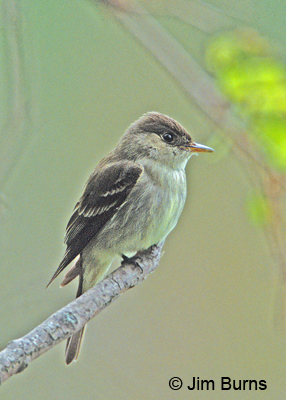Unintended Consequences
March 26, 2009

Willow Flycatcher
All birders interested in sustaining the environmental diversity that supports their passion, and their planet, soon bump up against the hard rock of unintended consequences. Here's a primer course. Let's call it Unintended Consequences 101. Tamarisk, Tamarix ramosissima, an exotic, invasive tree was brought to the southwestern deserts in the 1800s as an ornamental windbreak and stream bank stabilizer. In its new home on this continent Tamarisk has no predators and no diseases. Stop me if you've heard this one before.
Tamarisk, "notoriously fecund," advances twelve miles per year. It reproduces both vegetatively and sexually, the latter by disseminating pinhead sized seeds into the air and water, onto the feathers and fur of passing birds and mammals, and onto your clothing. It is estimated that one tree produces 25 x 10 to the eighth power seeds every year. Do the math and you'll see a lot of zeroes, and you'll now see extensive Tamarisk stands throughout Arizona, Nevada, and as far north as Wyoming and North Dakota.
Here's the answer to "So what?" This invader's other name is Salt Cedar. It is a water hog capable of sucking up nine acre-feet of water per year per single tree, returning back into the soil salts so concentrated that native willow and cottonwoods cannot grow. The dams on our western rivers have prevented the periodic floods that might have washed away these salts, our stream banks have become ecological deserts, and Salt Cedar itself is both flood and drought resistant.
This is relevant to birders because the extimus subspecies of the Willow Flycatcher, our southwestern deserts' canary-in-the-coal-mine for their life sustaining riparian waters, has been placed on the Endangered Species list consequent in part to its ancestral willow habitat being choked out by Salt Cedar. There are three ways to counter this foreign invasion: chain saws and tractors (very labor intensive); chemical spraying (talk about "unintended consequences!"); and a defoliating beetle imported from Tamarisk's Kazakhstan homeland thought capable of reducing our present Salt Cedar plague by 85%.
But wait! Our Willow Flycatcher has proven to be an opportunist just like the invader that caused its demise. Willow Flycatchers have begun nesting in Tamarisk. That would be good news for the bird, if not our rivers themselves, except that the Department of Agriculture (USDA) released those defoliating beetles in 2005. Have you guessed that now those beetles are defoliating Tamarisk groves along the Virgin River in southern Utah and northwestern Arizona where Willow Flycatchers had adapted to nesting without willows?. Extima may be displaced. Again.
The Center for Biological Diversity has sued the USDA, under the Endangered Species Act, for failure to develop and implement a viable plan to safeguard the flycatcher from the very plan devised to safeguard it from the Tamarisk invader in the first place. This is the law of unintended consequences twice over. It's a complicated web our species weaves. Hopefully we learn something before the tapestry of our planet's diversity of life completely unravels.
Tamarisk, "notoriously fecund," advances twelve miles per year. It reproduces both vegetatively and sexually, the latter by disseminating pinhead sized seeds into the air and water, onto the feathers and fur of passing birds and mammals, and onto your clothing. It is estimated that one tree produces 25 x 10 to the eighth power seeds every year. Do the math and you'll see a lot of zeroes, and you'll now see extensive Tamarisk stands throughout Arizona, Nevada, and as far north as Wyoming and North Dakota.
Here's the answer to "So what?" This invader's other name is Salt Cedar. It is a water hog capable of sucking up nine acre-feet of water per year per single tree, returning back into the soil salts so concentrated that native willow and cottonwoods cannot grow. The dams on our western rivers have prevented the periodic floods that might have washed away these salts, our stream banks have become ecological deserts, and Salt Cedar itself is both flood and drought resistant.
This is relevant to birders because the extimus subspecies of the Willow Flycatcher, our southwestern deserts' canary-in-the-coal-mine for their life sustaining riparian waters, has been placed on the Endangered Species list consequent in part to its ancestral willow habitat being choked out by Salt Cedar. There are three ways to counter this foreign invasion: chain saws and tractors (very labor intensive); chemical spraying (talk about "unintended consequences!"); and a defoliating beetle imported from Tamarisk's Kazakhstan homeland thought capable of reducing our present Salt Cedar plague by 85%.
But wait! Our Willow Flycatcher has proven to be an opportunist just like the invader that caused its demise. Willow Flycatchers have begun nesting in Tamarisk. That would be good news for the bird, if not our rivers themselves, except that the Department of Agriculture (USDA) released those defoliating beetles in 2005. Have you guessed that now those beetles are defoliating Tamarisk groves along the Virgin River in southern Utah and northwestern Arizona where Willow Flycatchers had adapted to nesting without willows?. Extima may be displaced. Again.
The Center for Biological Diversity has sued the USDA, under the Endangered Species Act, for failure to develop and implement a viable plan to safeguard the flycatcher from the very plan devised to safeguard it from the Tamarisk invader in the first place. This is the law of unintended consequences twice over. It's a complicated web our species weaves. Hopefully we learn something before the tapestry of our planet's diversity of life completely unravels.